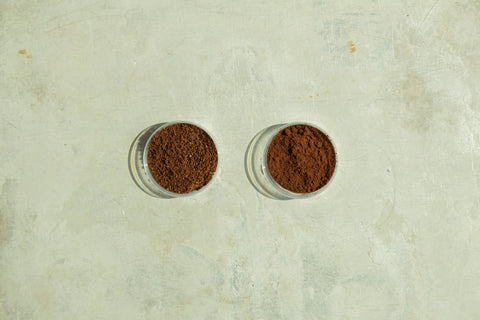Coffee grinding is much more than just mechanical grinding. It represents a fundamental sensory and chemical control parameter in coffee extraction.
From a physico-chemical point of view, grinding determines the specific surface area of coffee exposed to water, thus influencing the transfer rate of soluble compounds such as chlorogenic acids, sugars, caffeine and aromatic oils.
The fineness of the grind, its particle size distribution (PSD) and its uniformity act in synergy with the brewing method to influence contact time, pressure and flow turbulence. Too fine a grind causes over-extraction (dry, bitter taste), too coarse a grind causes under-extraction (empty, acid taste). In a professional context, this is a factor of standardization as well as yield optimization.
Continue reading to find out which grind is optimal for your favourite extraction method.
Espresso
For espresso, the grind* must be ultra-fine, almost like flour, between 200 and 250 microns. This is what enables the water, pushed at around 9 bars of pressure, to pass rapidly through the coffee in 25 to 30 seconds.
But beware: a poorly packed or uneven grind can cause a phenomenon known as channelling: the water follows preferential paths through the coffee cake, resulting in uneven extraction. The result? A cup with an unbalanced taste, sometimes bitter or hollow.
Grind: espresso
| espresso manual / pro | espresso auto / semi-auto |
| 02 | 03 |

Pour over (infusion)
Pour over methods such as the V60, Kalita Wave or Chemex require a medium to medium-fine grind, rather like raw sugar (between 500 and 700 microns). Too fine a grind can clog the filter, lengthening extraction time and giving a bitter taste. Conversely, an unevenly distributed coffee bed or irregular water flow can cause uneven extraction, resulting in a loss of aroma.
Grind: infusion
| v60, kalita | chemex | cafetière (filtre panier) |
| 05 | 06 | 08 |

Immersion (piston)
French press
The French press requires a coarse grind, the size of sea salt (between 800 and 1000 microns). The piston press is ideal for this method, where the coffee brews in complete immersion for around 4 minutes. Here, too fine a grind allows particles to pass through the metal filter, making the cup cloudy and grainy.
Aeropress
The Aeropress is a versatile extraction tool, offering two main methods: the classic method (filter downwards) and the inverted method (immersion infusion, then inversion for extraction).
classic method: we recommend a medium-fine grind (600 to 800 microns), similar to table sugar. The coffee is brewed briefly, then pressed through a paper filter to produce a clean, well-balanced cup.
Inverted method: the coffee is fully immersed for 1 to 2 minutes before being pressed. You can then opt for a slightly coarser grind, to avoid over-extraction and obtain a rounder, sometimes fuller-bodied cup.
Grind: immersion
| french press | aeropress classic | aeropress inverted |
| 11 | 06 | 08 |

Others
Moka pot (Italian Stove Brewer)
The ideal grind is fine, but slightly coarser than for espresso (around 300 to 400 microns). It should provide good resistance without blocking the passage of water. If the grind is too fine, the filter can become blocked, creating excessive pressure. If it's too coarse, the water passes through too quickly, leaving the coffee watery and under-extracted.
Cold brew
Requires a very coarse grind, often around 900 to 1100 microns. Too fine a grind releases bitter compounds and makes the coffee cloudy or even muddy. Too coarse and the infusion becomes too weak and watery. The expected result is a smooth, rounded coffee with low acidity.
Percolator
A medium grind is required, comparable to that used for filter coffee (around 600 microns). Too fine a grind accentuates this problem, producing a bitter, full-bodied coffee; too coarse a grind produces a weak, unbalanced infusion.
Syphon
The grind should be medium, similar to that used for pour-over (between 500 and 600 microns). If the grind is too fine, it slows the coffee's return to the lower chamber and can burn it; if it's too coarse, the infusion is too rapid and the taste diluted. Properly controlled, the syphon produces a clear, complex and highly aromatic coffee.
k-cups (capsules)
The grind, pre-adjusted at the factory, is generally very fine and similar to that used for espresso.
Turkish
It requires an extremely fine grind, almost as fine as flour or talcum powder (less than 100 microns), so that the coffee remains in suspension and forms a stable sedimentation at the bottom of the cup. Too coarse a grind prevents the coffee from settling properly and makes the texture unpleasant.
Grind: others
| moka pot | 04 |
| cold brew | 11 |
| percolator | 08 - 09 - 10 |
| syphon | 06 |
| k-cups | 04 |
| turkish | 01 |

Conclusion
Adjusting the grind to the extraction method is essential to reveal the full complexity and richness of the coffee's aromas. Whether you prefer the intensity of an espresso, the finesse of a pour over or the richness of an aeropress, the right grind is the key to a successful cup.
* Warning!
We strongly recommend using whole beans when purchasing specialty coffee.
Ground coffee quickly loses its aroma and freshness, sometimes in just a few days. By choosing whole beans, you're ensuring a cup that's more flavourful, more expressive and more true to the quality of the coffee we roast with care.
Please note that all our ground coffees are prepared with our MAHLKÖNIG precision grinder. Each roaster may use different grinding parameters, and it's only natural that you'll need to experiment a little to find the perfect grind for your brewing method.
Happy extracting!
Marie-Claire Marquis
Research
Références
CNET. (2015). Coffee grind size – why it matters and what you should be using. https://www.cnet.com/home/smart-home/coffee-grind-size-why-it-matters-and-what-you-should-be-using/
Counter culture coffee. Guide to Cold Brew.
https://counterculturecoffee.com/blogs/counter-culture-coffee/guide-to-cold-brew
Home Grounds. (2023). Coffee Grind Chart – Which Grind for Different Brewing Methods? https://www.homegrounds.co/coffee-grind-chart
Bon appetit. (2023). Everything You Need to Make Siphon Coffee Like a Chemist
https://www.bonappetit.com/story/everything-you-need-to-make-siphon-coffee-like-a-chemist
Coffee Chronicler. (2023). grind size chart & Data.
https://coffeechronicler.com/grind-size-chart/
Kruve. (2021). Grind Size Reference Guide. https://www.kruveinc.com/pages/brew-guide




Comments (0)
There are no comments for this article. Be the first one to leave a message!